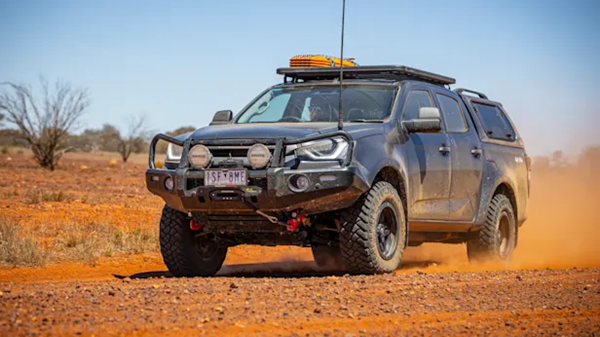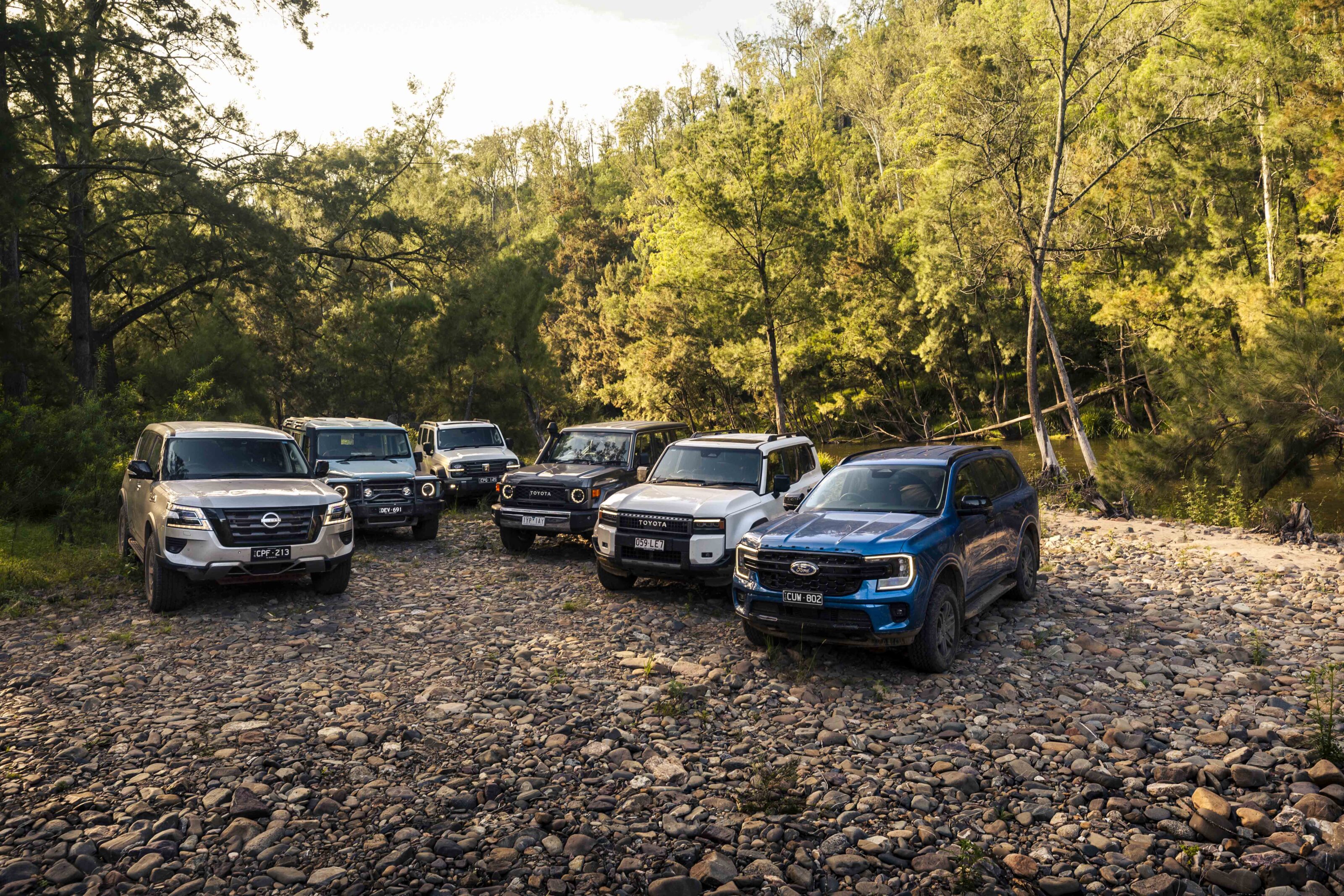Things we like
- Solid feeling and engineering
- Simple controls and functionality
- Great at off-road driving and load hauling
Not so much
- Showing its age when compared to newer utes
- Noisy and harsh engine
- Safety tech lacking behind the class leaders
The 2022 Toyota Hilux continues to be Australia’s most popular new car, and when it comes to mid-size 4×4 utes the Hilux SR5 is a perennial favourite.
We’re driving the 2022 Hilux SR5 here which is fitted with the Premium package and automatic transmission to take its price to $64,430 plus on-road costs. The Premium package adds heated leather seats and trim to give the ute’s interior a more upmarket rather than a totally utilitarian feel.
The current model of Toyota’s venerable ute is the N80 Hilux; the eighth generation of Toyota’s mid-size ute which, over more than 50 years has developed in to one of the world’s leading and most recognised vehicles.
The N80 Hilux was introduced in 2015 and it was only back in 2020 when it received its latest updates including the all-important improvements to the 1GD-FTV engine.
Upgrade your 4×4
-
Bullbars

-
Underbody Protection

-
4X4 Tyres

-
Canopies

-
Roof Racks

-
Storage


Powertrain
The 4×4 Hilux is available with a choice of 2.4 and 2.8-litre versions of the four-cylinder diesel engine depending on the model grade chosen.
The high-spec models such as the SR5 we’re testing here, are all powered by the bigger 2.8-litre version. There is also a choice of manual or automatic transmissions, bother offering six speeds.
The 1GR 2.8-litre engine received a considerable improvement as part of the 2020 model updates, notably in its torque output which jumped up to 500Nm to match its class-leading competitors.
It wasn’t just about peak torque for the Toyota engine as the extensive upgrades improved the engine’s performance right through its delivery range, dramatically improving the Hilux’s drivability. This was especially true when matched to the 6-speed automatic transmission where in the past, it had hunted through the gears while trying to find the sweet spot in the engine.
There’s none of that indecisiveness in the current iteration of the power train, the engine is punchy and delivers plenty of grunt, placing it at the pointy end of the four-cylinder powered 4×4 utes in terms of performance, and the transmission is perfectly matched to its output.
The only real criticism of the Toyota engine is its harshness and noise which sounds and feels very much like a noisy old diesel rather than a totally modern one. There’s still room for improvement in this regard.

On road ride and handling
The Hilux has always felt firm in its suspension, and this is following Toyota revising the spring rates in 2020 to soften the ride of the unladen vehicle.
It’s better than it was but it still feels stiff and tall when driving on road, reflecting its working truck roots and load carrying abilities.
There’s nothing wrong with the way the Hilux rides and drives, it’s just that some newer utes are changing the way cars in this segment perform to make them more passenger friendly, although sometimes that is at the expense of laden performance.

Off road
Like any Toyota 4×4, the Hilux’s strengths lie in its gravel road and off-road performance.
To this end, Toyota has given the Hilux class leading rear-axle articulation and the sharpest electronic traction control calibration (ETC) in the segment to ensure it gets over most rough terrain without fuss.
There are no fancy drive modes or tricks to the Hilux’s superior tractive abilities just quality suspension and ETC tune developed over decades of use in the harshest conditions.
The Hilux does have a rear differential lock (RDL) but engaging it kills the ETC across the front axle leaving the car a three-wheel drive instead of four. Once one of the front wheels starts spinning, the front axle become useless so it relies on the locked rear end. As such, the Hilux will often get over tricky obstacles easier using just the excellent ETC and not the RDL.

Interior
The Hilux’s cabin is another part of the car that has been upgraded through the life of this eighth-gen model, and each time it is an improvement.
The dash’s eight-inch screen was updated to give a dial for volume control and made easier to use, but many people we speak to don’t like the way the screen sits on the dash as opposed to being more integrated. Personally, I have no problem with it.
The system features wired access to Apple CarPlay and Android Auto, and Toyota’s factory sat-nav system has excellent mapping which is often more detailed than Google maps.
The gauge binnacle is simple and easy to read with none of the configurable customisation that other brands feel is necessary these days. It still tells the driver everything he or she needs to know at a quick glance that doesn’t require your eyes to leave the road any longer than they should.

The leather-trimmed seats that form the Premium package combine with the piano-finish black trims to add a feel of luxury and quality to the ute’s cabin. The SR5 Premium’s front seats are also heated.
The SR5 was rated as a winner as a family vehicle in our recent mid-size ute ‘Daily Living’ comparison test because getting the child seats in it was easy and they felt most secure. It also had the largest amount of space for an adult sitting in the middle between two child seats, a decent amount of room in the doors for storing drinks and toys, and the test vehicle was fitted with easily wipeable optional leather upholstery.
There’s a 220V power outlet in the cabin for charging devices in addition to the usual USB and ciggie lighter power outlets.
The Hilux does drop behind in not having all the latest safety technology. It has the essentials like ABS, ESC, ETC, AEB buts its lane-departure system doesn’t offer proper steering correction, nor does it have features like blind-spot indicators or rear cross-traffic.
This deficiency in safety tech is as much to do with the age of the current model Hilux when compared to newer models like the Ranger, Triton, BT-50 and D-MAX.

Practicalities
The SR5 has a 995kg payload, a 2980kg GVM, 3500kg towing rating and 5850kg Gross Combined Mass (GCM). These are all reasonable figures for a 1-tonne double-cab ute with a premium interior.
Those interior inclusions like powered leather seats all add weight and eat in to your payload and GCM.
The Hilux SR5 rides on 265/60R18 tyres which are becoming a common size for utes, but you can fit the smaller and more practical 17-inch wheels off the lower grades for better tyre choices.
The Hilux’s cargo tray is smaller than that of some in this class but has tie-down points low in the four corners where they are most useful but no 12V power outlet for powering accessories.
The Hilux’s engine bay has space for a second battery and the air intake is well-placed where it draws from the inner ’guard.
As one of the worlds most popular vehicles, the Hilux is extremely well-supported by aftermarket accessories manufacturers and Toyota offers a healthy range of factory kit for the ute including steel and alloy bullbars.
These accessories allow owners to tailor the ute to their own requirements be it as a work vehicle, touring around the country, or a combination of both.
VERDICT
The Hilux has long been a favourite for both private and fleet buyers, and there are good reasons for this.
Those decades of development have ensured that the Hilux remains near the top of the mid-size 4×4 1-tonne ute class due to its solid engineering and feeling, capability straight out of the box, and user-friendliness and functionality. All attributes you want on a ute that serve you for work, play and family duties.
4X4 Australia's project builds
2022 Toyota Hilux SR5 specs
| PRICE | $64,430 |
|---|---|
| ENGINE | I4 Diesel |
| CAPACITY | 2775cc |
| MAX POWER | 150kW at 3400rpm |
| MAX TORQUE | 500Nm from 1600 to 2800rpm |
| TRANSMISSION | 6-speed automatic |
| CRAWL RATIO | 36.11:1 |
| 4X4 SYSTEM | Part-time w/ high and low range 4×4 |
| CONSTRUCTION | 4-door ute body on ladder chassis |
| FRONT SUSPENSION | IFS w/ dual control arms and coil springs |
| REAR SUSPENSION | Live axle riding on leaf springs |
| TYRES | 265/60R18 on alloy wheels |
| KERB WEIGHT | 2093kg |
| GVM | 3050 |
| PAYLOAD | 995kg |
| TOWING CAPACITY | 3500kg |
| SEATS | 5 |
| FUEL TANK | 80L |
| ADR FUEL CLAIM* | 8.1L/100km |
| ON-TEST FUEL USE | 11.6L100km |
| DEPARTURE ANGLE | 28u00b0 |
| APPROACH ANGLE | 29u00b0 |
| WADING DEPTH | 700mm |
| GROUND CLEARANCE | 216mm |
Things we like
- Solid feeling and engineering
- Simple controls and functionality
- Great at off-road driving and load hauling
Not so much
- Showing its age when compared to newer utes
- Noisy and harsh engine
- Safety tech lacking behind the class leaders













